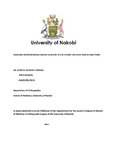| dc.contributor.author | Chomba, Dorcas W | |
| dc.date.accessioned | 2017-12-14T05:45:25Z | |
| dc.date.available | 2017-12-14T05:45:25Z | |
| dc.date.issued | 2017 | |
| dc.identifier.uri | http://hdl.handle.net/11295/101854 | |
| dc.description.abstract | .1 BACKGROUND
Soft-tissue injuries in closed fractures are less obvious than in open fractures, but still have
enormous importance. The evaluation of soft tissue injury in closed fractures can be much more
difficult than open fractures and the severity is easily underestimated. Of note is that closed
fractures are much more common than open fractures, i.e. of all fractures recorded it is
estimated only 3% are open fractures. Understanding soft tissue status is important as the
effective treatment of any fracture depends upon good soft tissue management. The current
methods of soft tissue assessment include clinical examination or use of imaging. Specifically
MRI and U/S which are expensive or not readily available. This study aims at establishing the
relationship between the pattern of closed fracture femur as defined in the AO classification and
severity of soft tissue injury by measuring the creatine phosphokinase levels in serum.
1.2 OBJECTIVE
To measure the serum creatine levels in patients with closed fracture femur as a biochemical
marker of degree of muscle injury and correlate this to AO fracture pattern classification.
1.3 STUDY DESIGN
Cross-sectional multi-centre hospital based study
1.4 SETTING
The patients were recruited from two Kenyan hospitals that deal with trauma patients, Kenyatta
National Hospital Accident and Emergency department, Orthopeadic wards and Orthopaedic
clinic, Kikuyu Mission Hospital.
1.5 METHODOLOGY
Consecutive sampling of patients presenting in KNH with isolated closed fracture femur was
done. Their blood samples were collected at 48hrs after the time of injury. The blood samples
were transported to Lancet at specified conditions optimum for CK analysis. The CK analysis was
done using the COBAS INTEGRA 400/800 whose test principle measures the rate of production
of β-Nicotinamide Adenine Dinucleotide which is directly proportional to CK activity. The levels
of CK was correlated to fracture pattern as classified in AO classification of shaft fractures.
1.6 DATA PROCESSING
The collected data was coded and analysed using Microsoft Excel, SPSS 20. and represented in
the form of percentages, means and their 95% confidence intervals.
2 | P a g e
The results showed the following, males were more than the females but females were
predominant in the group that had pathological fractures. All the patients except one had
normal BUN levels. None of the patients had clinical signs of compartment syndrome or ABI less
than 0.9.There was a correlation between the mechanism of injury and CK levels, CK levels and
urea/creatine ration but no correlation between CK levels and fracture pattern. Also noted
were many outliers thought to be due to other contributing factors. Females had a generally
lower amount of CK compared to the males. Those who sustained pathological fractures had CK
levels within normal.
1.7 CONCLUSION
There is a correlation between mechanism of injury and CK levels, CK and urea/creatine
ration. No correlation was noted between fracture pattern and BUN levels or CK and fracture
pattern or CK and BUN levels. | en_US |
| dc.language.iso | en | en_US |
| dc.publisher | University of Nairobi | en_US |
| dc.rights | Attribution-NonCommercial-NoDerivs 3.0 United States | * |
| dc.rights.uri | http://creativecommons.org/licenses/by-nc-nd/3.0/us/ | * |
| dc.subject | Creatine Phosphokinase Serum Levels in Acute Closed Isolated Femur Fractures. | en_US |
| dc.title | Creatine Phosphokinase Serum Levels in Acute Closed Isolated Femur Fractures. | en_US |
| dc.type | Thesis | en_US |
| dc.description.department | a
Department of Psychiatry, University of Nairobi, ; bDepartment of Mental Health, School of Medicine,
Moi University, Eldoret, Kenya | |



